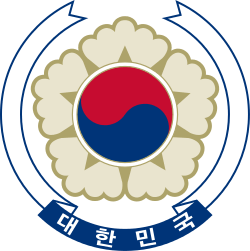Supreme Council for National Reconstruction
| Supreme Council for National Reconstruction of the Republic of Korea | ||||||||||
| 대한민국 국가재건최고회의 大韓民國 國家再建最高會議 | ||||||||||
| ||||||||||
| ||||||||||
 South Korea in Green. | ||||||||||
| Capital | Seoul | |||||||||
| Languages | Korean | |||||||||
| Government | Military junta | |||||||||
| Chairman | ||||||||||
| • | 1961 | Chang Do-yong | ||||||||
| • | 1961–1963 | Park Chung-hee | ||||||||
| Legislature | National Assembly suspended | |||||||||
| Historical era | Cold War | |||||||||
| • | May 16th coup | 16 May 1961 | ||||||||
| • | Establishment of the Third Republic | 17 December 1963 | ||||||||
| Currency | South Korean won | |||||||||
| ||||||||||
| Today part of | | |||||||||
| Supreme Council for National Reconstruction | |
| Hangul | 국가재건최고회의 |
|---|---|
| Hanja | 國家再建最高會議 |
| Revised Romanization | Gukga Jaegeon Choego Hoe-ui |
| McCune–Reischauer | Kukka Chaekǒn Ch'oego Hoeǔi |
Part of a series on the |
||||||||||||||||||||||||||||||||||||||||||||||||||||||||||||||||||
|---|---|---|---|---|---|---|---|---|---|---|---|---|---|---|---|---|---|---|---|---|---|---|---|---|---|---|---|---|---|---|---|---|---|---|---|---|---|---|---|---|---|---|---|---|---|---|---|---|---|---|---|---|---|---|---|---|---|---|---|---|---|---|---|---|---|---|
| History of South Korea | ||||||||||||||||||||||||||||||||||||||||||||||||||||||||||||||||||
 | ||||||||||||||||||||||||||||||||||||||||||||||||||||||||||||||||||
|
||||||||||||||||||||||||||||||||||||||||||||||||||||||||||||||||||
|
| ||||||||||||||||||||||||||||||||||||||||||||||||||||||||||||||||||
The Supreme Council for National Reconstruction, initially named the Military Revolutionary Committee, was a military junta that oversaw the government of South Korea from May 16, 1961 until the inauguration of the Third Republic of South Korea in 1963. It was composed largely of military officers who were involved in or supportive of the May 16 coup which overthrew the Second Republic of South Korea. The council was chaired initially by Chang Do-yong, and subsequently by Park Chung-hee. The president of the Second Republic, Yun Po-sun, stayed in office as a figurehead.
Key events
A military coup led by Major General (later Lieutenant General/General) Park Chung-hee on May 16, 1961 put an effective end to the Second Republic. Park was one of a group of military leaders who had been pushing for the de-politicization of the military. Dissatisfied with the cleanup measures undertaken by the Second Republic, they chose to take matters into their own hands.
The military leaders promised to return the government to a democratic system as soon as possible. On December 2, 1962, a referendum was held on returning to a presidential system of rule, which was allegedly passed with a 78% majority.[1] Park and the other military leaders pledged not to run for office in the next elections. However, Park ran for president anyway, winning narrowly in the election of 1963.[1]
Economy
The Supreme Council was the first South Korean government to introduce economic planning. The first South Korean five-year plan was inaugurated in 1962. Although the Second Republic had laid the groundwork for such plans, it had not been able to put them into practice.
See also
Notes
References
- Yonhap News Agency (2004). Korea Annual 2004. Seoul: Author. ISBN 89-7433-070-9.
.svg.png)
.svg.png)